Department Overview
We might call this the year of innov-AI-tion, with all the continued attention on and discussion of generative AI in higher education. And while we did spend a lot of time this year exploring, testing, presenting on, and organizing around generative AI, we also continued to cultivate a culture of innovation and a focus on user experience in our work throughout the year.
This year was a milestone for us, as our team grew and our scope expanded from ITS Innovation to Innovation, Digital Experience, and Accessibility (IDEA). The CSU’s Accessible Technology Initiative found a new home in ITS, and alignment with the skills and values on the IDEA team. This new name reflects our goal to explore emerging technologies systematically and responsibly, centering user experience and digital accessibility and equity. Our team leverages approaches from design thinking, user experience design, and universal design principles to enhance digital experiences for students, faculty, and staff, with a focus on diversity, equity, and inclusion.
For our 2024 ITS Innovation Annual Report, we showcase our key achievements and initiatives of the past year. In this report, you will find examples of how we have fostered a culture of innovation, enhanced digital experience, and re-invigorated the accessible technology community across the California State University system. We have collaborated with Chancellor’s Office departments and CSU campuses to explore and implement new solutions that enhance teaching, learning, and service delivery. We are proud of what we have accomplished and excited about what lies ahead.
Innovation
We foster a culture of innovation that is rooted in the principles of user experience and universal design. We explore emerging technologies, cultivate communities of practice around emerging technologies, and advocate for accessibility and equity in new technologies that have the potential to enhance the digital experience.
Digital Experience
We conduct user research and develop design strategies to create or improve user experience based on users’ needs and organizational goals. We offer “design as a service” to support the efficiency, accessibility, and delight of digital experiences.
Accessibility
We advance digital accessibility principles, standards, and processes at scale from an equity and social justice lens. We support and coordinate accessibility communities of practice and identify opportunities for shared services in order to meet or exceed CSU’s policy of making information technology resources and services accessible to all CSU students, faculty, staff and the general public regardless of disability.
Where Did We Go...?
What Were We Talking About...?
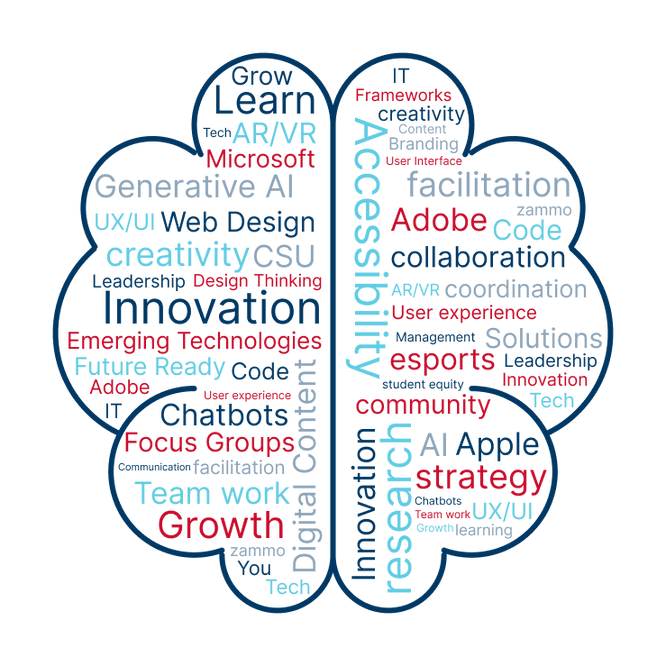
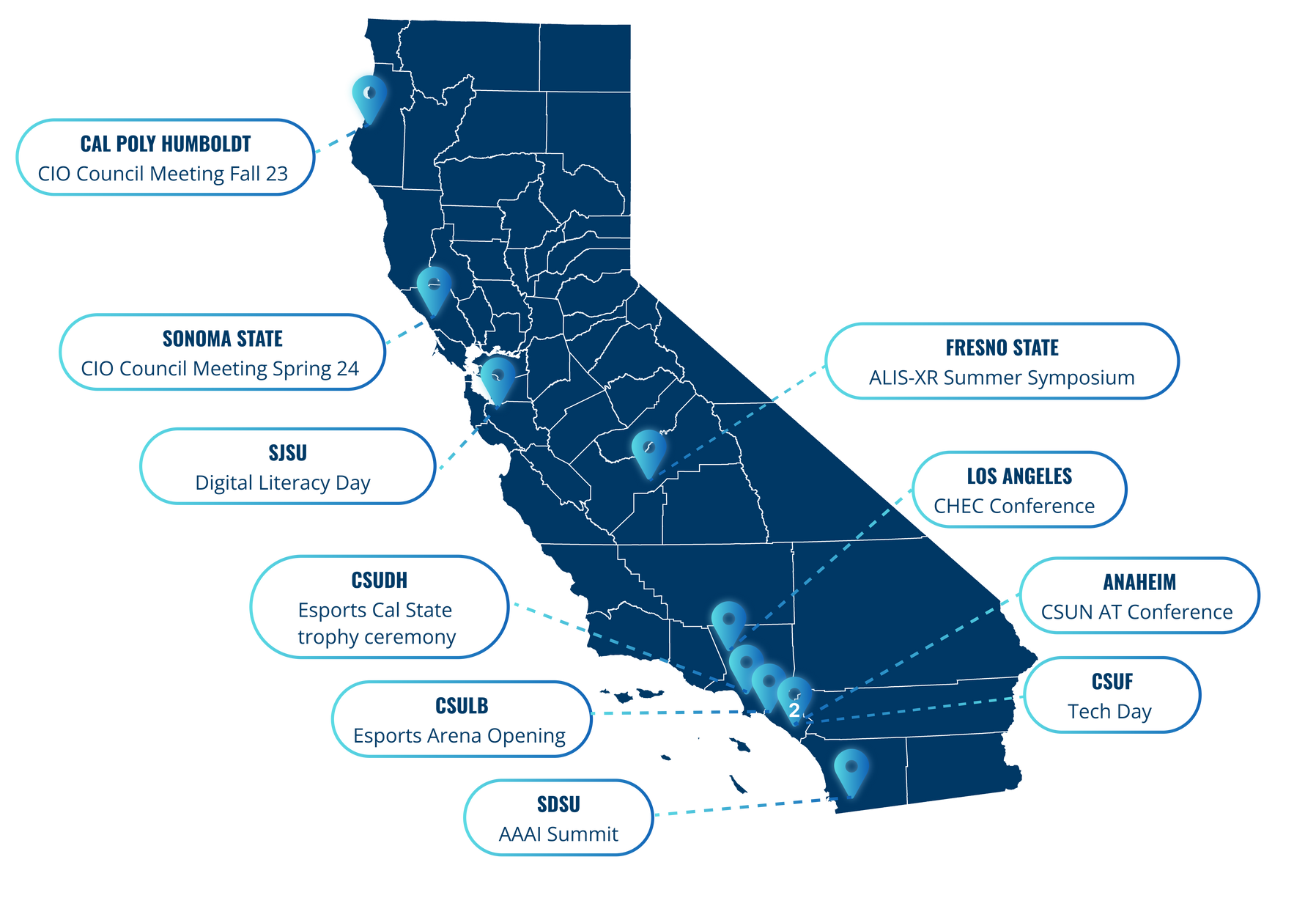
Meet the Team
Meet the superheroes of IDEA! Armed with keyboards, code, and brilliant solutions, they're here to save the day by solving problems and keeping everything running smoothly.
Key Accomplishments
2023-2024 Minigrant Cohort
In spring of 2023, ITS-Innovation was able to award Innovation Minigrants to campuses to kickstart pilots and projects focusing on explorations of emerging technologies to support teaching, learning, and research, or IT operations and efficiencies. Innovation areas included improving the student experience, exploring artificial intelligence & machine learning, and improving the efficiency of technology deployment and support. Awardees have spent this past academic year developing their work and we can’t wait to see how their innovations and solutions impact their campuses.
Congratulations to all the minigrant recipients!
- CSULB, Virtual Assistant Technology
- SFSU, Improved Mobile Personalized Mobile Messages through Modo push notification API
- CSUSB, High Performance Computing Support for Data Analytics Courses
- CSUSB, CodyAI: The Personal Virtual Learning Assistant for Online Courses
- CSUB, From Learning to Earning: Reducing Instructional Materials Costs with Technology and Innovation
- SFSU, An AI Toolkit for Teachers
- SSU, E-Sport Arena: Fostering Excellence and Community Engagement
- Stan State, Telepresence Robot Fleet & Faculty Learning Community
- CSUDH, Student Belonging Through Research and Technology
Zammo Pilot
In collaboration with the Technical Operations team, we experimented with chatbots powered by generative AI using the Zammo platform and Microsoft Azure services. We developed two prototypes – one for Policy Stat and one for the Accessible Technology Initiative.
Ask Eric, the Policy Stat chatbot, responds to natural language queries with citations from the CSU’s policy library.
The ATI chatbot provides guidance on accessibility based on CSU policies, best practices, and our maturity model.
These prototypes helped us understand the strengths and limitations of generative AI for delivering relevant and useful information to users. We intend to evaluate more solutions in the next academic year.
CSU Generative AI Committee
Generative AI is a disruptive force in higher education, requiring thoughtful and agile governance and guidance as the CSU navigates these technologies. Catalyzed by the Faculty Senate and the CIO Council, the CSU Generative AI Committee was formed, co-sponsored by Academic Affairs and Information Technology Services and co-chaired by Dr. Nathan Evans, Deputy Vice Chancellor for Academic and Student Affairs, and Dr. Ed Clark, Chief Information Officer. Kate Miffitt (Sr. Director, IDEA) coordinated and facilitated the cross-functional, cross-campus committee. Members were appointed to the committee by the co-chairs, with the goal of ensuring that the committee included representation from key functional areas. The committee met regularly from January 2024-May 2024 to develop the initial guidelines and recommendations for the CSU on generative AI. Three sub-committees were formed on focus areas including teaching, learning, and scholarship; security, privacy, and procurement; and applications for enhanced productivity. Read the final report by the committee and other related documents.
How Did Kate Lend Her Super Powers?
Key Accomplishments
ServiceNow User Research
ITS Service Management sought to conduct user experience research in partnership with ITS Innovation into ServiceNow to better understand diverse user perspectives and to prioritize opportunities for improvement. Allison Green (UX Designer, IDEA) conducted focus groups with staff from eight departments that use ServiceNow, considered the experiences of two primary categories (requestors and fulfillers), found a set of common challenges, and, lastly, suggested recommendations and longer-term goals for ITSM to consider. Users shared challenges that span a lack of timely training and consistent processes, form interface and design issues, and inefficient communications. Users also shared a range of recommendations, including assistive tools, streamlined processes and notifications, and other hinting features that would improve the user experience for both fulfillers and requestors.
Green compiled a comprehensive report that ultimately recommended that ITSM further investigate ways to streamline processes and be more consistent across departments, establish a governance structure that represents various ServiceNow stakeholders to advise on improvements, and leverage change management resources and approaches to improve acceptance and adoption of any changes implemented to the broader ServiceNow community. The following report outlines findings, recommendations, goals, and user personas to guide design strategy in further detail.
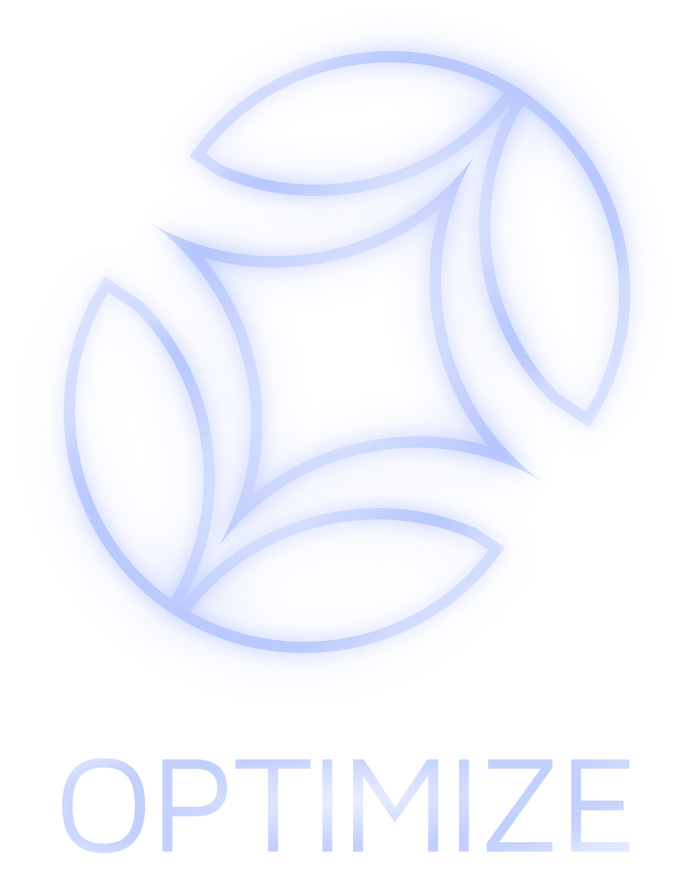
Optimize Branding
Following the feedback from fall’s ServiceNow user research, IT Productivity Services developed a strategy to implement more changes to optimize the ServiceNow user experience. With a plan in place to release the new experience fully in Fall 2024, IDEA’s design team created a brand and style guide for the refreshed instance called Optimize. At the request of Productivity Services, we created:
- Logo and wordmark variations,
- Color Palette and typography,
- Favicon for web browsers and Microsoft App Launcher,
- Optimize Backgrounds that can be used for (i.e. Zoom, SharePoint, PowerPoint, Websites, Marketing Assets, etc.),
- Merchandise mockups,
- Brand guidelines.
“Optimize is not just a label, but a reflection of our commitment to continuous improvement.”
Chris O’Connell, Associate Director of Productivity Services
Statuspage UX/UI Consultation
The digital experience team collaborated with members of the Technical Operations unit to lead the UX/UI design of the new systemwide services status dashboard. Internally known as “Statuspage,” this platform will serve as a communication tool to automate the notification of services between CO and the campuses. Technical Operations requested that IDEA rebrand the templatized platform to match the interface to the CSU brand. Initial deliverables for the rebrand included:
- Color palette,
- Logo and wordmark,
- Favicon for web browsers and Microsoft App Launcher.
After analyzing Statuspage site with the initial changes, further UX recommendations called for modifying HTML and CSS to better display information to users. Further changes to Statuspage led to the creation of a header and footer to highlight resources, matching typography to CSU-approved fonts, and web-accessible color choices for status updates.
Press play above to see the prototype and click below to see the website live (protected behind SSO).
Digital Accessibility & Equity
Overview
The Accessible Technology Initiative (ATI) aims to ensure that all information technology resources and services are accessible to everyone, including individuals with disabilities. This initiative is part of CSU's commitment to creating an inclusive learning and working environment. This longstanding program moved to ITS over the last year, and is being re-vitalized as the core program elements resume.
Key components of the ATI include:
- Procurement: Ensuring that all technology products and services acquired by CSU meet accessibility standards.
- Web Accessibility: Making sure that all CSU websites and web-based applications are accessible to users with disabilities.
- Instructional Materials: Guaranteeing that all educational materials are accessible, including textbooks, course content, and multimedia resources.
The ATI will continue to provide training, resources, and community to faculty, staff, and students to support the implementation of accessible technologies across all CSU campuses.
Reconvening ATI Executive Sponsors and Communities of Practice
The ATI Executive Sponsors and Communities of Practice started meeting regularly again, reconnecting the communities and reasserting priorities and collaborations. These regular touchpoints enable information dissemination and the sharing of best practices, particularly as the ATI program revises its annual reporting process and prepares for elevated digital accessibility standards per Title II ADA compliance. These communities have a new home on SharePoint Online, which CSU colleagues are welcome to join.
Key Accomplishments
Investments in Core ATI Infrastructure
As part of the effort to reboot the ATI, investments were made to reinvigorate latent programs and services. The Accessible Technology Network (ATN) will resume activity, with a focus on updating the Capability Maturity Model to reflect updated standards of the DOJ Title II ADA ruling. The ATI annual reporting template is also being redesigned to make reporting both easier and more accurate, with clearer expectations for evidence.
Work is underway to rebuild AIMHub to better enable the sharing and discovery of remediated digital content. And we pre-purchased 900 seats for Web AIM training, to support faculty and staff interested in creating accessible documents. Finally, we procured systemwide licensing for low-/no-vision assistive technologies that can be installed on any machine in the CSU, as well as personal devices for users who need it who have a .edu email address. These initial efforts will position us to make great progress in the coming year as the ATI community prepares to meet new regulatory standards and to improve digital accessibility for students, faculty, and staff.
Phil Hill & Associates Report and Findings
During the ATI transition from ASA to ITS, Phil Hill & Associates were brought in to analyze the current state and make recommendations on the future of ATI. The report provides near-term and long-term priorities for the CSU’s accessibility program. Key suggestions include reaffirming commitment to ATI by bringing in interim leaders, resetting ATI goals to align with broader system objectives, and reestablishing a baseline for accessibility standards. The report also emphasizes the need to define ATI roles and responsibilities clearly, make organizational changes to improve workflows, and create a communication plan to engage executive stakeholders. This report will help us to prioritize steps and aim to ensure sustainable and effective accessibility practices throughout the CSU system.
How Did Leon Lend His Super Powers?
ATI Communities of Practice
The ATI Communities of Practice bring together campus practitioners from the three priority areas of the Accessible Technology Initiative (ATI): web, instructional materials, and accessible procurement of Information and Communication Technology (ICT). The CoP meets monthly, and also has active Slack channels and a SharePoint site for information-sharing and connection.
Esports Common Interest Group
Esports Cal State is a systemwide network created to engage students, staff, faculty, and administrators to promote each campus’ esports program and to share best practices in sustaining vibrant and competitive communities. Of the 23 CSU campuses, 18 schools have at least one esports group. Esports Cal State is supported by a collaborative ITS team that facilitates the common interest group, chaired by Jaclyn Crouch, sports club program advisor, of Sacramento State. The esports Common Interest Group (CIG) meets monthly, with a focus on campus updates, space and equipment needs and goals, and organizational structures that support esports for students.
Communities & IDEA Events
Design Community
of Practice
ITS Innovation proudly hosts a UX/Design community of practice for members of the CSU. The CoP exists to create a systemwide network of designers that can collectively learn, collaborate, and grow with one another. Realizing that human-centered service design aligns with the goals of innovation, the community corresponds via periodic newsletters, plans events built around skill development, and maintains a network of designers across many areas of campuses.
XR Common
Interest Group
Under the continued leadership of co-chairs Dr. Sean Hauze of SDSU and Dr. Mihaela Popescu of CSUSB, ITS Innovation coordinated the Extended Reality Common Interest Group for its second year. This year, the group explored a variety of topics during the monthly meetings throughout the academic year. Topics included the Role of XR in Cultural Preservation, designing an OEXR repository, Features and Roadmap of the Apple Vision Pro, and Immersive Media and Embodied Cognition.
CSU + Adobe
Advisory Council
The Adobe Advisory Council meets three times a year to inform the direction of the CSU partnership with Adobe and get input from diverse stakeholders from throughout the system that represent varying roles and perspectives. The purpose of the council is to leverage the scale of the CSU to promote digital fluencies, share information, and improve equitable access.
OEXR Sub-Committee (EDUCAUSE)
Based on interest among the EDUCAUSE Extended Reality Community Group in sharing and finding open educational AR/VR resources, a sub-committee was established in Fall 2023 to identify the requirements of an OEXR Library. Co-chaired by Dr. Sean Hauze (SDSU), Kate Miffitt served as a member of this sub-committee, which designed and administered a survey to a global higher education audience, conducted focus group discussions at Fresno State University, and wrote a paper summarizing the findings of the research. Next steps include conducting an RFP-like process to identify a platform and to pilot the OEXR library with the community.

Esports Cal State Cup featuring
Tournament Overview
On March 2, ITS Innovation collaborated with other ITS partners of Esports Cal State to organize the second annual Cal State Cup featuring Overwatch 2. Twelve teams representing nine campuses competed and CSU Dominguez Hills graciously offered to broadcast the tournament stream to Twitch from their on-campus broadcasting studio for the second year in a row. CSU Dominguez Hills coincidentally overtook San Diego State in the Grand Finals in game four of the five game series and stole the opportunity from SDSU for a second tournament win.
The Chancellor’s Office hand-delivered the perpetual plaque to CSUDH on May 6 to honor the campus’s victory; CSUDH Esports offered a tour of their state-of-the-art Toro Esports Academy- their institution-wide gaming space. CO staff experienced the classroom, competitive arena, incubator space, and broadcast room. The campus also arranged for staff and administrators from the Division of Information Technology and the University President’s Office to attend the trophy ceremony and celebrate the victory.
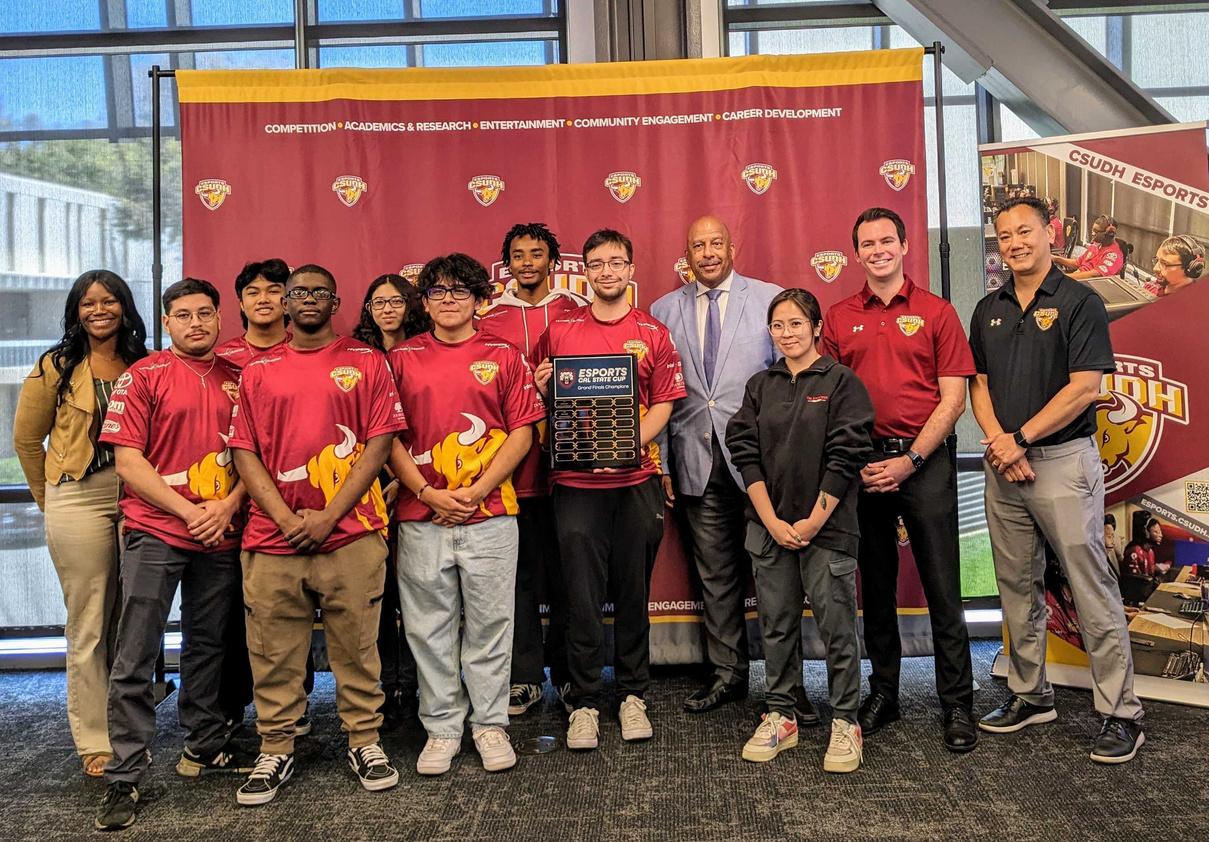
Esports Cal State members, Allison Green and Angel De Leon, present the coveted tournament perpetual plaque to the winning Overwatch 2 team at CSUDH’s awards ceremony.
See the players in action!


Cal State CREATE is a CSU-wide creative event and competition in collaboration with Adobe and Apple, and the planning committee wanted the theme to be relevant and timely. This year's theme, "Future Ready in the CSU", explored areas of emerging technologies, career readiness, and what it means to be prepared for our evolving world. Key changes from last year included an abridged schedule from two weeks to one (April 8-12) and the modification from a student competition to open-ended student challenges to encourage more participation.
To kick off Cal State CREATE events, a panel of professionals from various industries shared their experiences of how technology and digital literacy shape their work and help with their success. Following the kickoff session, Apple and Adobe professionals hosted sessions focusing on trends in the workplace, how to best leverage AI, and how to maximize current tools in each product suite. ITS Innovation uploaded event recordings on the Cal State CREATE YouTube Playlist.
Students also participated in a visual design challenge to create assets and artifacts with Adobe and Apple tools to demonstrate their digital skills and to develop their professional personas. By following a road map of challenges that ranged from preparing for internships and the workforce to experimenting with innovative Adobe and Apple tools, participants created practical assets that showcase their skills for their futures. Examples of the submissions included stylized resumes, digital calling cards, pre-recorded one-way interviews, and more.
For each challenge submitted in accordance with the specifications, participants received an entry into the raffle to win a set of Apple AirPods Pro or informational interviews with Apple and Adobe professionals! Congratulations to our prize winners and view some samples of participants’ submissions below!
Student Work Highlights
Work created by CSU students: Michael Butorac, Tammy Cao, Ava Cenizal, Ronna L. Del Rosario, Adrienne Liang, Shelby Matthews, Isaiah Molina, Shazid Shaik and Kristina Solomita

Professional Events & Conferences
CAL STATE TECH CONNECT
ITS-Innovation had a presence at the Cal State Tech Connect Conference in July 2023 as a part of the planning committee and as presenters. Staff partnered with Fresno State’s Hub for Digital Transformation (DXI) to present a session entitled “Analyzing the Student Digital Experience through User Research” overviewing the previous year’s student digital experience research project and subsequent pilot launch of a student-facing solution.
The user experience designers from both teams also led a hands-on workshop on building and utilizing user personas titled, “Creating “Persona” Connections: Develop User Personas to Promote User-Centered Design.”
Lastly, the senior director co-facilitated a session with the XR CIG co-chairs named “Reality Bytes: A Journey Through Extended Reality in the CSU “ to explore the uses of XR technologies across the system.
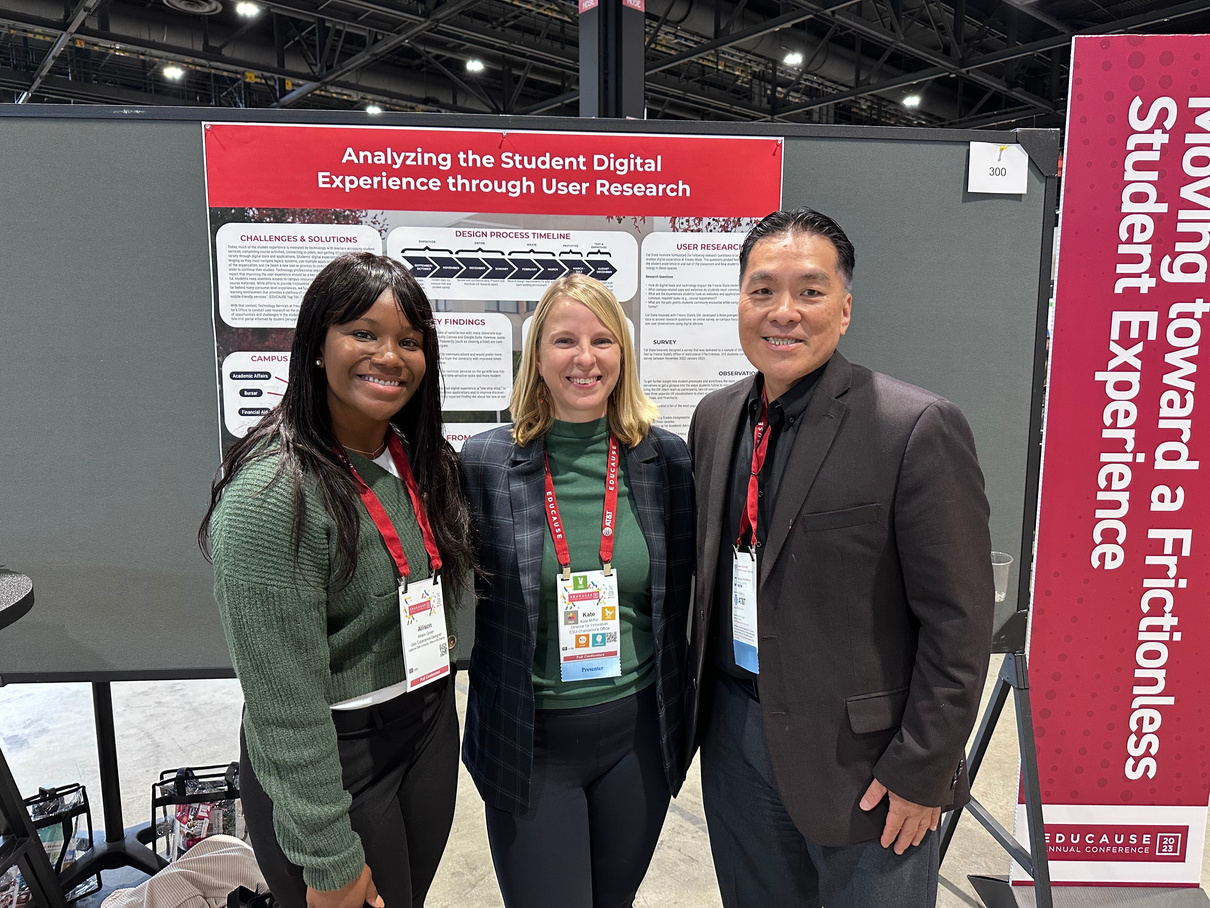
EDUCAUSE
At the 2023 EDUCAUSE Annual Conference in Chicago, IDEA staff were featured in the program. Continuing to share insights and development from last year’s user research study at Fresno State, the team co-presented a poster called “Analyzing the Student Digital Experience through User Research” which visually displayed the project life cycle from engaging campus stakeholders, identifying design priorities, and producing a viable prototype that led to the launching of a student portal. Kate Miffitt also served as a panelist in two sessions on generative AI. One was a featured session entitled, “Boom or Bust? The Future of Generative AI in Higher Education;” the other was a leadership series panel discussion on “ChatGPT and Generative AI: Navigating Leadership Opportunities and Challenges.”
California Higher Education Collaborative Conference (CHEC)
The team attended the 2023 California Higher Education Collaborative Conference (CHEC) in late fall semester and presented a session called “Centering the Student: How to Integrate User Experience Practices into Your Work” as a part of the Culture & Engagement track. Focusing on the importance of integrating user experience processes in nearly any work flow and project, the team led participants in several hands-on exercises to develop both user personas and journey maps for future projects.
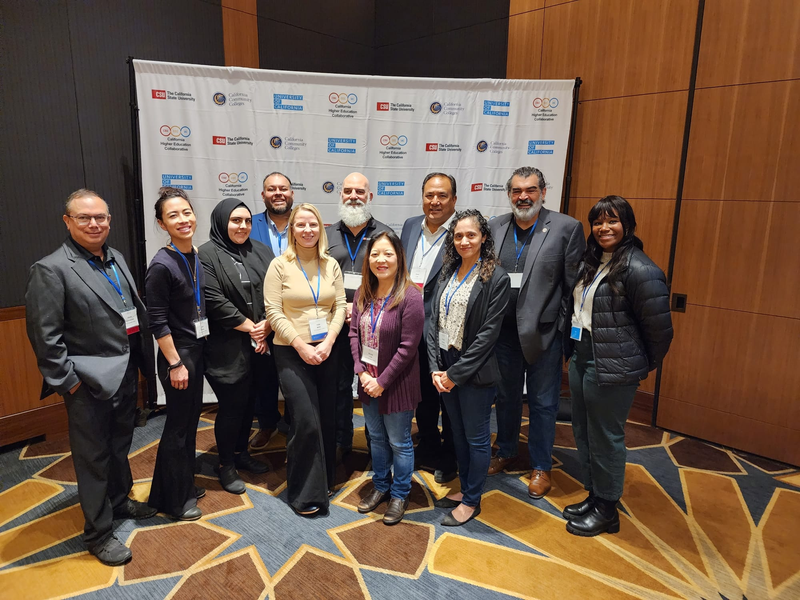
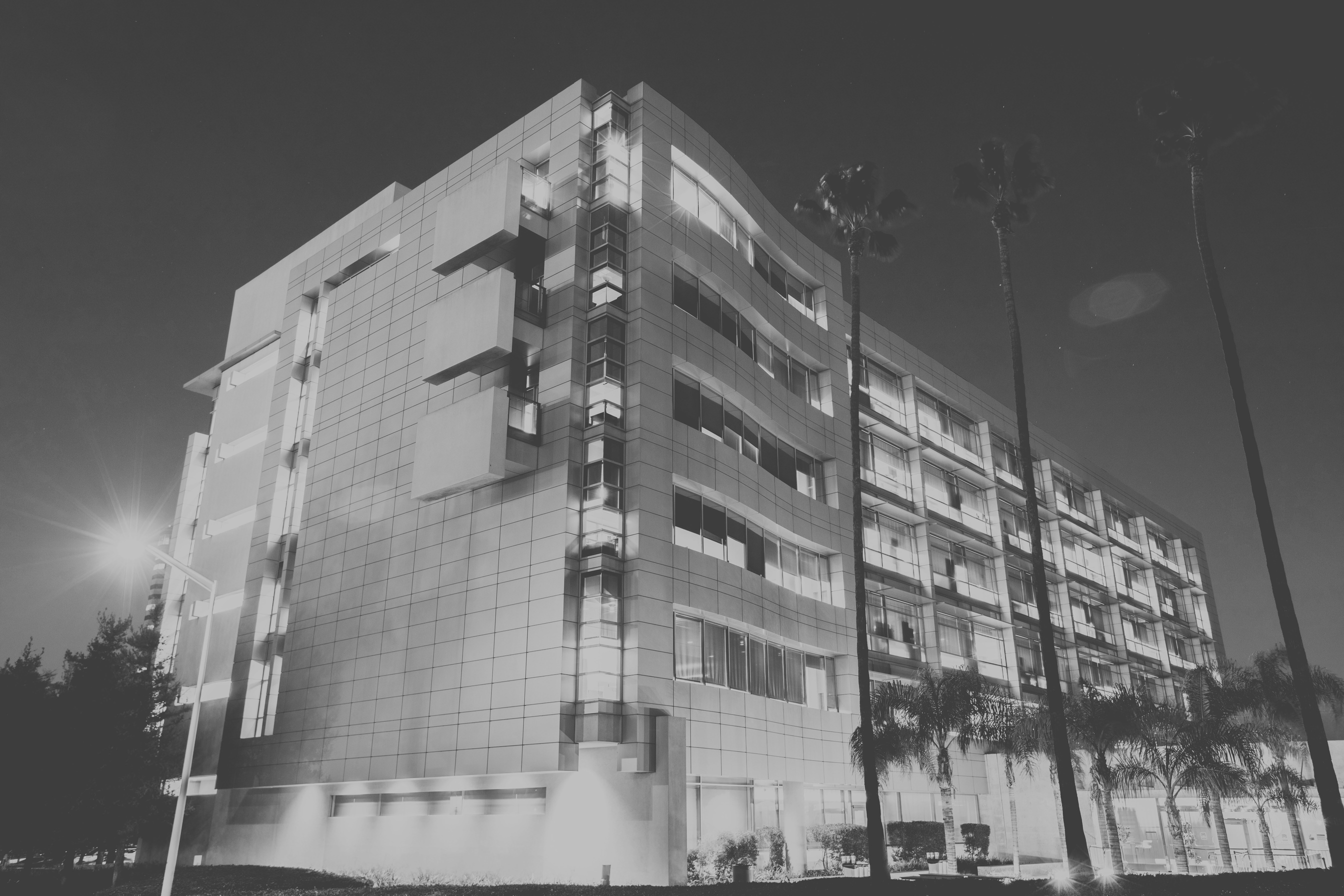
Conclusion
This was a significant year of transitions, accomplishments, and ongoing community-building and explorations of emerging technologies. The report showcases some of the key highlights of the year, as well as the unit’s leadership and impact through its projects, communities of practice, and contributions to the CSU community and professional organizations.
Looking ahead, the unit has several goals and plans for the next year. We’ll continue to support the ongoing coordination of and experimentation with generative AI. We’ll conduct user experience research for large redesign projects. And we’ll provide guidance and support as campuses prepare to meet elevated digital accessibility standards over the next two years. We’ll continue to support our communities and partnerships, and explore new technologies and trends. The department aims to lead efforts in creating a more accessible, inclusive, and innovative learning environment in the ever-changing landscape of higher education.
Thank you to our team, colleagues, and
partnerships for making this year possible!
401 Golden Shore
Long Beach CA 90802
innovate@calstate.edu
VISIT





